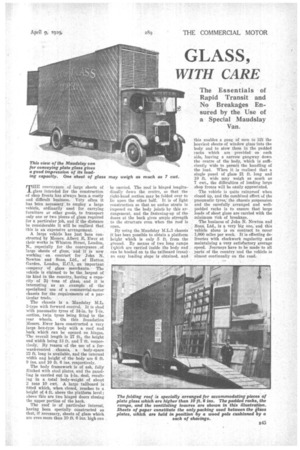GLASS,
Page 71

If you've noticed an error in this article please click here to report it so we can fix it.
WITH CARE
MEM conveyance of large sheets of
glass intended for the construction of shop fronts has always been a costly and difficult business. Very often it has been necessary to employ a large vehicle, ordinarily used for carrying furniture or other goods, to transport only one or two pieces of glass required for a particular job, and if the distance be considerable it will be• realized that this is an. expensive arrangement.
A large vehicle has just been Constructed by Messrs. Albert E. Ewer at their works in Whiston Street, London, N., especially for the conveyance , of large sheets of glass, ahd it is now working on. contract for John N. Newton " and Sons, Ltd., of Hatton. Garden, London, E.0.1, an important company of glass merchants. The vehicle is claimed to be the largest of its kind in the country, having a capacity of 21 tons of glass, and it is interesting as an example of the specialized use of a .commercial-motor chassis for the requirements of a particular trade.
The chassis is a -Maudslay M.L. 3-type with forward control. It is shod with pneumatic tyres of 34-in. by 7-in. sectien, twin tyres being fitted to the rear wheels. On this foundatiOn Messrs. Ewer have constructed a very large box-type body with a roof and back which can be opened on hinges. The overall length. is 27 ft., the height and width being 13 ft. and 7 ft. respectively. By reason of the use of a forward-control chassis, a body-space 22 ft. long is available, and the internal width and height of the body are 6 ft. 9 ins. and 10 ft. 6 ins. respectively. The body framework is of ash, fully ilitched with steel plates, and the panelling is carried out in i-in. deal, resulting in a total body-weight of about 2 tons 10 cwt. A large tailboard is fitted which, when closed, reaches to a height of 4 ft. above the platform level; above this are two hinged doors closing the upper portion of the back.
The roof is of particular interest, having been specially constructed so that, if necessary, sheets of glass which are even more than 10 ft. 6 ins, high can .
be carried. The roof is hinged longitu-• dimilly down the centre, so that the right-hand section may be folded over toile upon the other half. It is of light construction so that no undue strain is imposed on the body joints by this arrangement, and the fastening-up of the doors at the back gives ample strength to the structure even when the roof is open.
By using the Maudslay M.L.3 chassis it has been possible to obtain a platform height which is only 3 ft. from the ground. By means of two long ramps (Nehich are carried inside the body and can ba hooked on to the tailboard irons) an easy loading slope is obtained. and this enables a gang of men to lift the heaviest sheets of window glass into the body and to stow them in the padded racks which are provided on each side, leaving a narrow gangway down the centre of the body, which is sufficiently wide to permit the handling of the load. When it is realized that a single panel of glass 21 ft. long and 10 ft. wide may weigh as much as 7 ewt., the difficulties of leading large shop fronts will be easily appreciated.
The vehicle is quite rainproof when closed"Op, and the combined effect of the pneumatic tyres, the chassis suspension and the carefully arranged and well. padded racks is to ensure that large loads of sheet glass are carried with the minimum risk of breakage.
The business of John N. Newton and Sons, Ltd., is a very big One, and this vehicle alone is on contract .to 'cover 1,000 miles per week. it is effecting deliveries with clockwork regularity and maintaining a .very satisfactory average speed. Journeys have to be made to all parts of the country and the vehicle is almost continually on the road.




















































































































